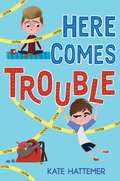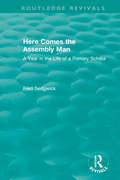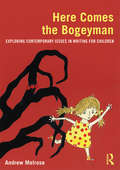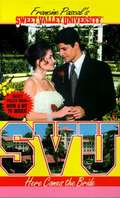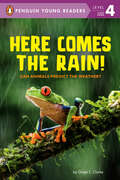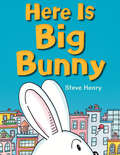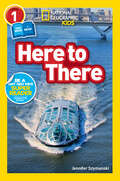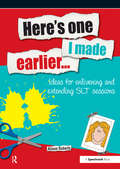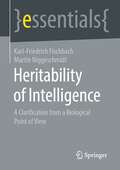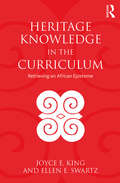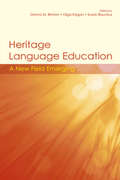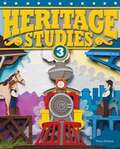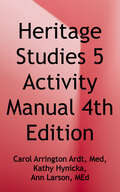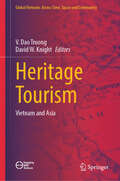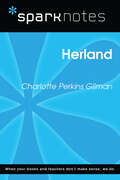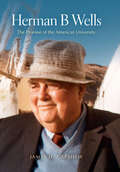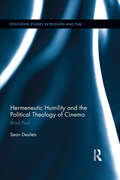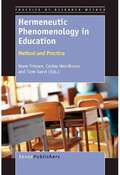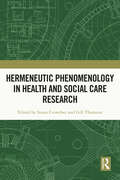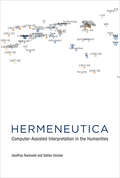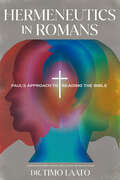- Table View
- List View
Here Comes Trouble
by Kate HattemerThe hilarious story of a wannabe-reformed-prankster perfect for readers who loved Dead End in Norvelt and Better Nate Than Never.Soren Skaar is a notorious prankster. After his partner-in-pranking-crime moves away, Soren's ready to leave his life of causing trouble behind. But when his hipster Brooklynite cousin comes to "study abroad" with his family in small-town Minnesota, Soren's plans for reform fall by the wayside. Soon all Soren can see are opportunities to prank, and his shenanigans have done nothing to win over his cousin. It isn't long before he's in over his head, and Soren can't help but wonder who he'll be if he loses this part of himself. Can he give up his life as a jokester, or is the joke on him?"Give this to fans of the "Wimpy Kid" series who are looking for longer novels."--SLJ"A fast, engaging read."--Booklist
Here Comes the Assembly Man: A Year in the Life of a Primary School (Routledge Revivals)
by Fred SedgwickOriginally published in 1989, this is a book about managing a real primary school – but, unlike most management books, it places the child at the centre of the exercise. It concentrates on an untidy reality rather than a system – on a human perspective rather than one which is manipulative of human reality. The books narrative structure makes it unique amongst other books in the field. Sedgwick writes with warmth and perception. His insights into the relations between the children and their teachers form part of a collage of material. Many accounts from parents, visitors, teachers and children are included in his colourful prose, providing other points of view and changes in narrative gear. Letters, poems, photographs and drawings complete the collage so that the book takes on a form which is appropriate to its subject – the randomness and variety of a school’s life. Here Comes the Assembly Man is always absorbing, at times highly amusing – a rewarding read for all parents, teachers and educationalists alike.
Here Comes the Bogeyman: Exploring contemporary issues in writing for children
by Andrew MelroseHere Comes the Bogeyman is an essential text focussing on critical and contemporary issues surrounding writing for children. Containing a critically creative and a creatively critical investigation of the cult and culture of the child and childhood in fiction and non-fictional writing, it also contains a wealth of ideas and critical advice to be shared with writers, students of children’s writing and students of writing. With scores of published children’s fiction books and films to his name, Andrew Melrose shares his extensive critical, teaching, writing and research experience to provide: a critical and creative investigation of writing and reading for children in the early, middle and pre-teen years an accessible and critically important challenge to the latest international academic research and debates in the field of children’s literature and creative writing. an evaluation of what it means to write for a generation of media-savvy children encouragement for critics, writers and students to develop their own critical, creative and writing skills in a stimulating and supportive manner guidance on writing non-fiction and poetry creative writing craftwork ideas which could be used as seminar topics or as individual reflections This ‘one-stop’ critical and creative text will be an indispensable resource for critics, writers and students interested in the cult and culture of writing for children; on Creative Writing BA and MA programmes; Children's Literature BA and MA programmes; English BA and MA programmes; Teacher Training, PGCE students and for those studying at Doctoral and Post-Doctoral level who are interested in writing for children.
Here Comes the Bride (Sweet Valley University #20)
by Francine Pascal Laurie JohnBillie doesn't know what's gotten into Steven Wakefield. She thought he was ready for marriage. Now he's busy quoting divorce statistics. Steven is not the happy groom-to-be. To Steven, Billie is acting downright moody. And the Wakefield house has turned to chaos--the caterers bailed with the deposit and the wedding rings are missing. Is it time to call the whole thing off?
Here Comes the Rain!: Can Animals Predict the Weather? (Penguin Young Readers, Level 4)
by Ginjer L. ClarkeLearn about whether or not animals around the world can sense the weather (spoiler alert - some can!) in this photographic nonfiction leveled reader perfect for kids interested in real-life animals that can do unbelievable things!Did you know that sharks have such sensitive hearing that they can tell when hurricanes are coming? Or that you can tell when it's about to rain when sheep start huddling together after they sense a storm on the wind? These animals are real-life weather predictors! With simple language and vivid photographs, Here Comes the Rain!: Can Animals Predict the Weather? is perfect for emerging readers curious about the natural world and the fascinating abilities of the animals that live within it.
Here I Stand: A Life of Martin Luther
by Roland Herbert BaintonOn an April evening over 400 years ago a simple monk faced the emperor of the Holy Roman Empire. His words, heard by only a roomful of people, have echoed through the centuries:My conscience is captive to the Word of God. I cannot and I will not recant any things for to go against conscience is neither right nor safe. Here I stand.Because he took his stand, Martin Luther shattered the structure of medieval Catholicism and initiated Protestantism.This authoritative, dramatic biography of Martin Luther interprets his experience, his work, writings, and lasting contributions. With sound historical scholarship and with keen insight into Luther’s religious problems and values it recreates the spiritual setting of the sixteenth century, shows Luther’s place within it and his influence upon it, and brings the spirit and message of Martin Luther to life today.Here I Stand is richly illustrated with woodcuts and engravings from Luther’s own time—satirical cartoons; ornamented title pages of tracts and books, including Luther’s Bible; and portraits of the leaders in the political and religious struggle. It is rich also in information and quotation from firsthand sources selected from the whole range of extant sixteenth-century German writings, including some hitherto unused in any studies in English. This is a significant contribution to Protestant faith—a vivid, discerning portrayal of the man who, because of unshakable faith in his God, could face his accusers and say: “Here I stand. I cannot do otherwise. God help me”
Here Is Big Bunny
by Steve HenryWhose giant foot is that? Where are those ears going . . . ? Through windows, behind trees, and behind buildings, Big Bunny is peeking out. More than one hundred fifty colorful animal characters, busily walking through their city, stop and look at the giant bunny in their midst. What could all of these clues add up to? Why, it's Big Bunny—a huge balloon, sailing down the street with a smile in the middle of a parade! Beginning readers will love searching through Steve Henry's detailed spreads for hints, looking for Big Bunny in each spread. The text features brief, simple sentences with no more than one word changing from page to page, making this one of the first books a child will be able to read on their own. For older readers, an author's note explains the inspiration behind the story, artistic influences, and some of the unexpected treasures hiding on the page. Bold colors and creative cutaways make this a fun read, and there's always some new detail to discover!
Here to There (Readers)
by Jennifer SzymanskiCar, trucks, planes, trains, bikes, gondolas, and even funiculars--there are so many ways to get around! Set out on a journey around the world to discover just how many vehicles we use to get from here to there.Whether you're canoeing down a river, zooming in a maglev train, or just simply walking, people are always on the move! In this book, young readers will explore the ways we travel through water, on land, and in the sky. National Geographic Kids Readers have been a hit in the beginning reader category, and this book builds upon that success with a new approach--parents and children reading together. With the same combination of careful text, brilliant photographs, and fun approach to high-interest subjects that has proved to be a winning formula with kids, National Geographic Co-readers provide one page of adult read-aloud and one page of kid read-aloud text on each spread, building toward a collaborative reading experience.
Here's Hilary (Third-Grade Friends #1)
by Suzanne WilliamsMeet Hilary Hopkins. Hilary is a total mess. She’s the queen of clutter. And you can usually tell what she’s eaten because she’s wearing it on her shirt! But Hilary doesn’t mind. That is, until her teacher gets upset that she’s late to School--again. But how will Hilary ever clean up her act when she can’t even clean out her desk? That’s where the secret plan comes in. It’s a deal that Hilary makes with the class geek, Gordon, to try to get her life in order. It’s a weird plan, but it’s worth trying. After all, third grade cannot get any messier than it already is! Look for book 2 in this series, Josh Taylor, Mr. Average.
Here's One I Made Earlier: Ideas for Enlivening and Extending SLT Sessions
by Alison RobertsThis imaginative and practical book contains a collection of ideas and games that should provide you with lots of new resources without spending a fortune. Some of the games and activities address particular communication themes, such as: listening techniques; speech sounds; vocabulary building; and friendship skills, while others cover several areas simultaneously. The book is organised into chapters according to the major skill area being addressed, with suggestion for linked items in other chapters. To add to well-established and structured programmes of therapy that SLTs use, there are two principles that can make for better therapeutic outcomes, and on which the book is based: clients often respond more effectively if they feel that they "own" their therapy by being involved in making the materials that they will use; and therapy is improved when it is good fun, and preferably humorous. You don't need to be a great artist or craftsman to create these games and activities, or huge quantities of spare time to make most of the items, especially if you can get organised with equipment all in one go. There is a basic shopping list to help you get started. It is a must have for all Speech and Language Therapists. It is presented in A4 wire-o-bound.
Heritability of Intelligence: A Clarification From a Biological Point of View (essentials)
by Karl-Friedrich Fischbach Martin NiggeschmidtIs intelligence heritable? Karl-Friedrich Fischbach and Martin Niggeschmidt show that "heritability" means something different in biological terminology than in everyday language - which almost inevitably leads to misinterpretations. They explain why twin studies are controversial - and why genetic predictions of IQ and "educational attainment" must be treated with skepticism. This book is a translation of the original German 2nd edition Erblichkeit der Intelligenz by Karl-Friedrich Fischbach & Martin Niggeschmidt, published by Springer Fachmedien Wiesbaden GmbH, part of Springer Nature in 2019. The translation was done with the help of artificial intelligence (machine translation by the service DeepL.com). A subsequent human revision was done primarily in terms of content, so that the book will read stylistically differently from a conventional translation. Springer Nature works continuously to further the development of tools for the production of books and on the related technologies to support the authors.The Authors:Prof. Dr. Karl-Friedrich Fischbach is a developmental biologist and neurogeneticist. He was professor of biophysics and molecular biology at the University of Freiburg from 1985 to 2013, including two years as executive director of the Institute of Biology III. Martin Niggeschmidt is an editor in Hamburg.
Heritage Knowledge in the Curriculum: Retrieving an African Episteme
by Joyce E. King Ellen E. SwartzMoving beyond the content integration approach of multicultural education, this text powerfully advocates for the importance of curriculum built upon authentic knowledge construction informed by the Black intellectual tradition and an African episteme. By retrieving, examining, and reconnecting the continuity of African Diasporan heritage with school knowledge, this volume aims to repair the rupture that has silenced this cultural memory in standard historiography in general and in PK-12 curriculum content and pedagogy in particular. This ethically informed curriculum approach not only allows students of African ancestry to understand where they fit in the world but also makes the accomplishments and teachings of our collective ancestors available for the benefit of all. King and Swartz provide readers with a process for making overt and explicit the values, actions, thoughts, and behaviors reflected in an African episteme that serves as the foundation for African Diasporan sociohistorical phenomenon/events. With such knowledge, teachers can conceptualize curriculum and shape instruction that locates people in all cultures as subjects with agency whose actions embody their ongoing cultural legacy.
Heritage Language Education: A New Field Emerging (Routledge Handbooks In Linguistics Ser.)
by Donna M. Brinton Olga Kagan Susan Bauckus"… focuses on issues at the forefront of heritage language teaching and research. Its state-of-the-art presentation will make this volume a standard reference book for investigators, teachers, and students. It will also generate further research and discussion, thereby advancing the field." María Carreira, California State University – Long Beach, United States "In our multilingual and multicultural society there is an undeniable need to address issues of bilingualism, language maintenance, literacy development, and language policy. The subject of this book is timely…. It has potential to make a truly significant contribution to the field." María Cecilia Colombi, University of California – Davis, United States This volume presents a multidisciplinary perspective on teaching heritage language learners. Contributors from theoretical and applied linguistics, sociolinguistics, psychology, educational policy, and pedagogy specialists explore policy and societal issues, present linguistic case studies, and discuss curricular issues, offering both research and hands-on innovation. - The term "heritage language speaker" refers to an individual exposed to a language spoken at home but who is educated primarily in English. Research and curriculum design in heritage language education is just beginning. Heritage language pedagogy, including research associated with the attrition, maintenance, and growth of heritage language proficiency, is rapidly becoming a field in its own right within foreign language education. This book fills a current gap in both theory and pedagogy in this emerging field. It is a significant contribution to the goals of formulating theory, developing informed classroom practices, and creating enlightened programs for students who bring home-language knowledge into the classroom. Heritage Language Education: A New Field Emerging is dedicated to Professor Russell Campbell (1927-2003), who was instrumental in advocating for the creation of the field of heritage language education.
Heritage Studies 5 Activity Manual
by Ann Larson Kathy Hynicka Carol Arrington ArdtHeritage Studies 5 Activity Manual (4th ed.) uses full-color pages to reinforce and enrich lessons. The manual contains graphic organizers, reinforcement pages, expansion pages, primary source documents, map skills, biblical evaluation of historical events, study guides, and chapter reviews.
Heritage Studies 6: Ancient Civilizations Activity Manual
by Bju PressHeritage Studies Grade 6, Ancient Civilizations Activity Manual, Fourth Edition by BJU Press
Heritage Studies: World Regions
by Bju PressWorld Regions is an age-appropriate study of our global community with a special emphasis on government and citizenship, geography and climate, resources and economics, culture, and religion. Stories and legends, engaging art and photos, maps, infographics, essential questions, and literacy skills features promote student learning.
Heritage Tourism: Vietnam and Asia (Global Vietnam: Across Time, Space and Community)
by V. Dao Truong David W. KnightThis book provides an overview of research and best practices associated with heritage tourism, with a particular focus on Vietnam, in conversation with heritage tourism in other Asian contexts. These include Iran in the Middle East, Sri Lanka in South Asia, Japan and China in East Asia, Thailand in Southeast Asia, and Brunei and the Philippines in the South Pacific. By delving into crucial questions and challenges relating to cultural innovation, preservation, and authenticity, it offers key lessons for policy-making and theorisation which not only contribute to understanding and improving heritage tourism in Vietnam, specifically, and in Asia more broadly, but also inform efforts to preserve and regenerate both natural and cultural heritage on a global scale. It is relevant to researchers and student communities working within areas of heritage, sustainability, tourism, geography, and in Asian studies.
Herland (SparkNotes Literature Guide Series)
by SparkNotesHerland (SparkNotes Literature Guide) by Charlotte Perkins Gilman Making the reading experience fun! Created by Harvard students for students everywhere, SparkNotes is a new breed of study guide: smarter, better, faster.Geared to what today's students need to know, SparkNotes provides:chapter-by-chapter analysis explanations of key themes, motifs, and symbols a review quiz and essay topics Lively and accessible, these guides are perfect for late-night studying and writing papers.
Herman B Wells: The Promise of the American University
by James H. CapshewEnergetic, shrewd, and charming, Herman B Wells was the driving force behind the transformation of Indiana University—which became a model for American public higher education in the 20th century. A person of unusual sensitivity and a skilled and empathetic communicator, his character and vision shaped the structure, ethos, and spirit of the institution in countless ways. Wells articulated a persuasive vision of the place of the university in the modern world. Under his leadership, Indiana University would grow in size and stature, establishing strong connections to the state, the nation, and the world. His dedication to the arts, to academic freedom, and to international education remained hallmarks of his 63-year tenure as President and University Chancellor. Wells lavished particular attention on the flagship campus at Bloomington, expanding its footprint tenfold in size and maintaining its woodland landscape as new buildings and facilities were constructed. Gracefully aging in place, he became a beloved paterfamilias to the IU clan. Wells built an institution, and, in the process, became one himself.
Hermeneutic Humility and the Political Theology of Cinema: Blind Paul (Routledge Studies in Religion and Film)
by Sean DesiletsThis book revisits the tradition of Western religious cinema in light of scholarship on St. Paul’s political theology. The book’s subtitle derives from the account in the Book of Acts that St. Paul was temporarily blinded in the wake of his conversion on the road to Damascus. In imitation of Paul, the films on which Sean Desilets’s analysis hinges (including those of Carl-Th. Dreyer, Robert Bresson, Pier Paolo Pasolini, and Carlos Reygadas) place a god-blind mechanism, the camera, between themselves and the divine. Desilets calls the posture they adopt "hermeneutic humility": hermeneutic in that it interprets the world, but humble in that it pays particular—even obsessive—attention to its own limits. Though these films may not consciously reflect Pauline theology, Desilets argues that they participate in a messianic-hermeneutic tradition that runs from Paul through St. Augustine, Blaise Pascal, Karl Barth, and Walter Benjamin, and which contributes significantly to contemporary discussions in poststructuralist literary theory, political theology, and religious studies. Desilets’s insightful explication of Jean-Luc Nancy’s deconstruction of Christianity and Georgio Agamben’s recent work on religion makes a substantial contribution to film philosophy and emerging critical trends in the study of religion and film. This book puts forward a nuanced theoretical framework that will be useful for film scholars, students of contemporary political theology, and scholars interested in the intersections of religion and media.
Hermeneutic Phenomenology in Education: Method and Practice (Practice of Research Method #4)
by Norm Friesen Tone Saevi Carina HenrikssonHermeneutic phenomenology is a combination of theory, reflection and practice that interweaves vivid descriptions of lived experience (phenomenology) together with reflective interpretations of their meanings (hermeneutics). This method is popular among researchers in education, nursing and other caring and nurturing practices and professions.
Hermeneutic Phenomenology in Health and Social Care Research
by Susan Crowther Gill ThomsonThis book explores how, why, and when hermeneutic phenomenology can be used as methodology in health and social research. Providing actual examples of doing robust hermeneutic phenomenology and a focus on praxis, the book demonstrates how philosophical or theoretical notions can inform, enrich and enhance our research projects. The chapters offer examples of many different research designs and interpretive decisions in order to illustrate the unbounded and creative nature of this type of inquiry, whilst also demonstrating the trustworthiness of the scientific processes adopted. The chapter authors invite the reader on a unique journey that highlights how they made individual and tailored decisions throughout their projects, emphasising the challenges and joys they encountered. This book is a valuable resource for all students and academics who wish to explore the meaningfulness of human lived experiences across the multitude of phenomena in health and social care.
Hermeneutica: Computer-Assisted Interpretation in the Humanities
by Stefan Sinclair Geoffrey RockwellAn introduction to text analysis using computer-assisted interpretive practices, accompanied by example essays that illustrate the use of these computational tools.The image of the scholar as a solitary thinker dates back at least to Descartes' Discourse on Method. But scholarly practices in the humanities are changing as older forms of communal inquiry are combined with modern research methods enabled by the Internet, accessible computing, data availability, and new media. Hermeneutica introduces text analysis using computer-assisted interpretive practices. It offers theoretical chapters about text analysis, presents a set of analytical tools (called Voyant) that instantiate the theory, and provides example essays that illustrate the use of these tools. Voyant allows users to integrate interpretation into texts by creating hermeneutica—small embeddable “toys” that can be woven into essays published online or into such online writing environments as blogs or wikis. The book's companion website, Hermeneuti.ca, offers the example essays with both text and embedded interactive panels. The panels show results and allow readers to experiment with the toys themselves.The use of these analytical tools results in a hybrid essay: an interpretive work embedded with hermeneutical toys that can be explored for technique. The hermeneutica draw on and develop such common interactive analytics as word clouds and complex data journalism interactives. Embedded in scholarly texts, they create a more engaging argument. Moving between tool and text becomes another thread in a dynamic dialogue.
Hermeneutics in Romans: Paul's Approach to Reading the Bible
by Timo Laato Bror Erickson Kristina Odom Weslie Odom"And behold, a lawyer stood up to put him to the test, saying, "Teacher, what shall I do to inherit eternal life?" He said to him, "What is written in the Law? How do you read it?" (Luke 10:25-26)Eternal life is found within the pages of Holy Scripture, both in the Old Testament Torah referred to as "the Law" in this exchange between Jesus and the lawyer, and in the New Testament written in the wake of Christ's resurrection. But as Jesus points out, it matters how you read Holy Scripture, and this is where the art of hermeneutics, the study of interpretation, makes its entrance. In Hermeneutics in Romans, Dr. Timo Laato returns to the old Lutheran maxim that scripture interprets scripture. Usually this maxim meant that portions of scripture that were clear should be used to shed light on portions of scripture that are unclear. Dr. Laato takes it even one step further. He turns to Romans to study the hermeneutical principles that Paul used to interpret the Old Testament in that epistle. This results in a dynamic view of the Bible, rescuing hermeneutics from the dead atheistic presumptions that have governed academic hermeneutical research since Kant. Not only does Dr. Laato's approach make immanent sense on the face of it, it breathes life into the study of scripture and delivers eternal life to the reader in Jesus Christ who proves to be the ultimate hermeneutical key.
